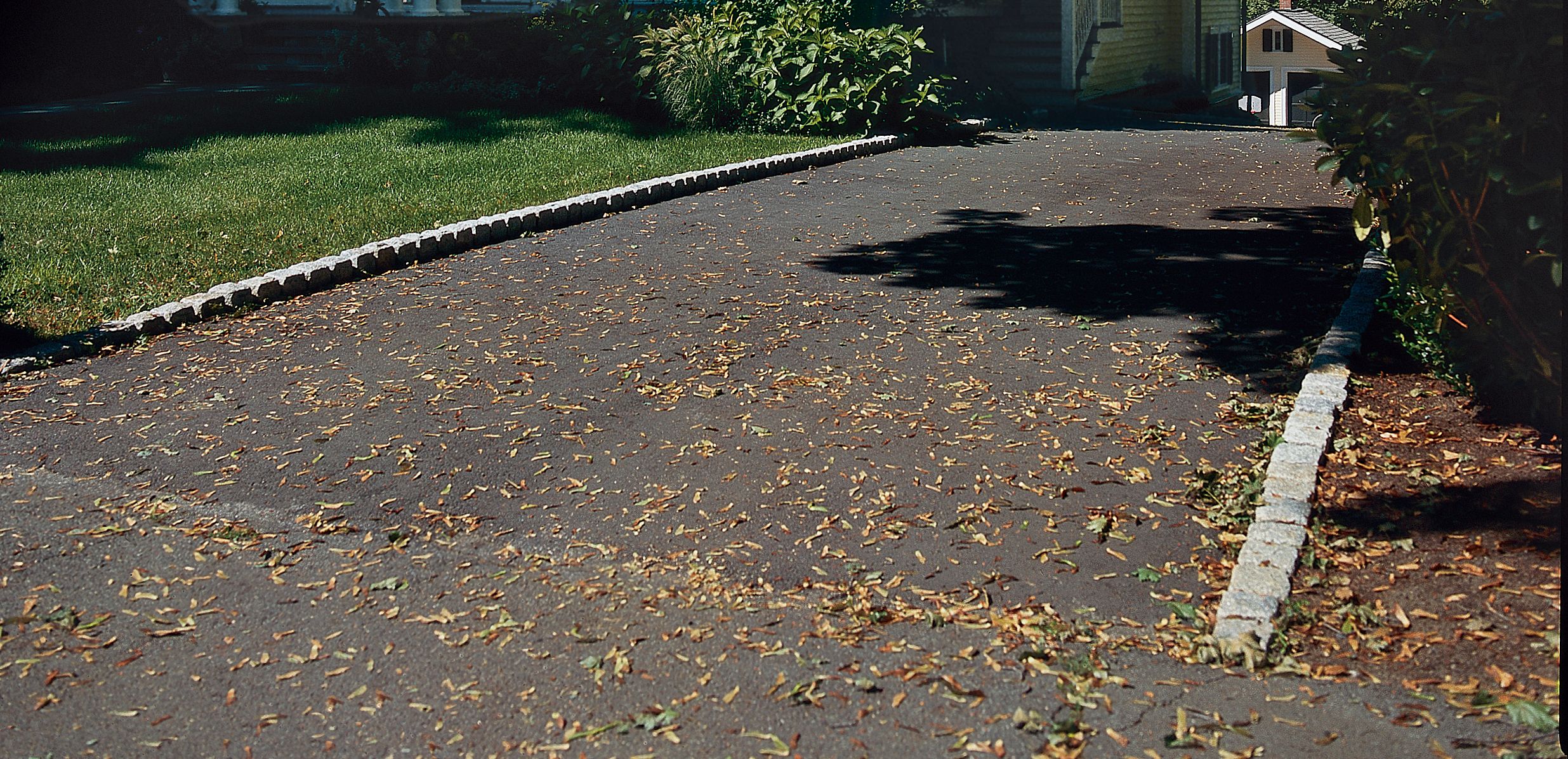Belgian block driveway edging uses durable granite cobblestones to create a defined border between your driveway and the surrounding landscape. This design can increase the visual appeal of your yard while also helping prevent erosion.
The sturdy blocks create a barrier that helps keep your driveway’s asphalt or concrete from crumbling at the edges. In this article, we’ll explore the installation process, cost, and maintenance requirements of Belgian block edging.
How To Install Belgian Block Driveway Edging
Installing Belgian block edging is a project that a skilled DIY enthusiast can complete in a weekend or two, depending on the length of the driveway.
Tools Required
You’ll need the following list of tools to effectively edge your driveway with Belgian blocks:
- Chalk line
- Cold chisel
- Diamond-bladed saw or grinder (if needed for cutting blocks)
- Level
- Mason’s line and stakes
- Rubber mallet
- Safety goggles
- Shovel
- Three-pound sledgehammer
- Trowel
- Wheelbarrow
Materials Checklist
You’ll want to choose and gather your materials for this project, which should include:
- Belgian blocks
- Concrete mix (or cement and sand for larger projects)
- Grass seed or mulch for finishing
- Stone dust or ground limestone for filling gaps
- Topsoil for backfilling
- Water for mixing concrete
Step 1: Plan and Prepare
Measure the length of your driveway to determine how many blocks you’ll need. You’ll need approximately 12 regulation blocks for every 5 feet of edging. To calculate the concrete required for the base, consider that a 60-pound bag of premixed concrete covers about two feet of setting bed.
Step 2: Excavation
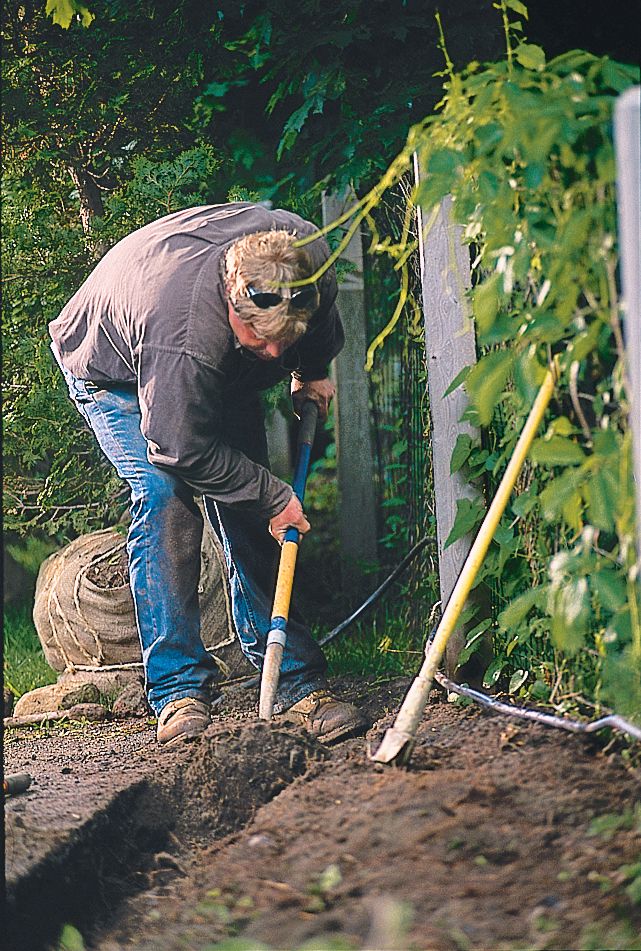
Dig a trench along the edges of your driveway. Each trench should be approximately one foot wide and eight inches deep. If your driveway has a slope, start at the highest point and work downhill to maintain proper drainage. As you dig, place the excavated soil in a wheelbarrow or on a tarp for later use in backfilling.
Step 3: Clean and Trim the Asphalt Edges
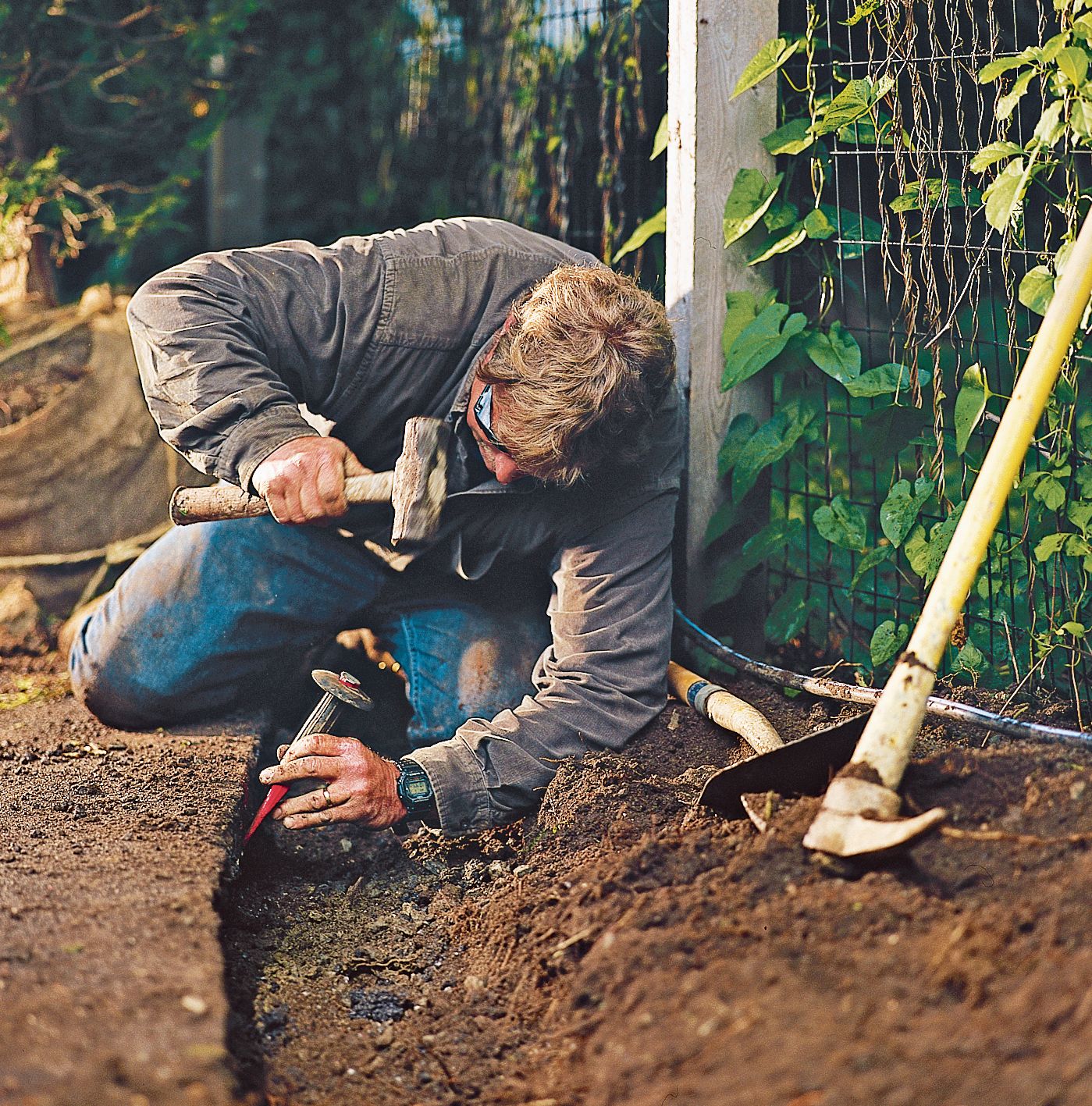
After excavation, you’ll create a clean edge along your driveway. Remember to wear safety goggles during this process. Start by snapping a chalk line on the pavement just inside the driveway’s edge. Using a cold chisel and three-pound sledgehammer, carefully chip away the asphalt along this line. We recommend checking whether your town offers asphalt recycling for these chunks.
Once you’ve removed the excess asphalt, trim the soil beneath the pavement flush with the new clean edge. This step ensures a straight, neat border for your Belgian blocks.
Step4: Stake and Line
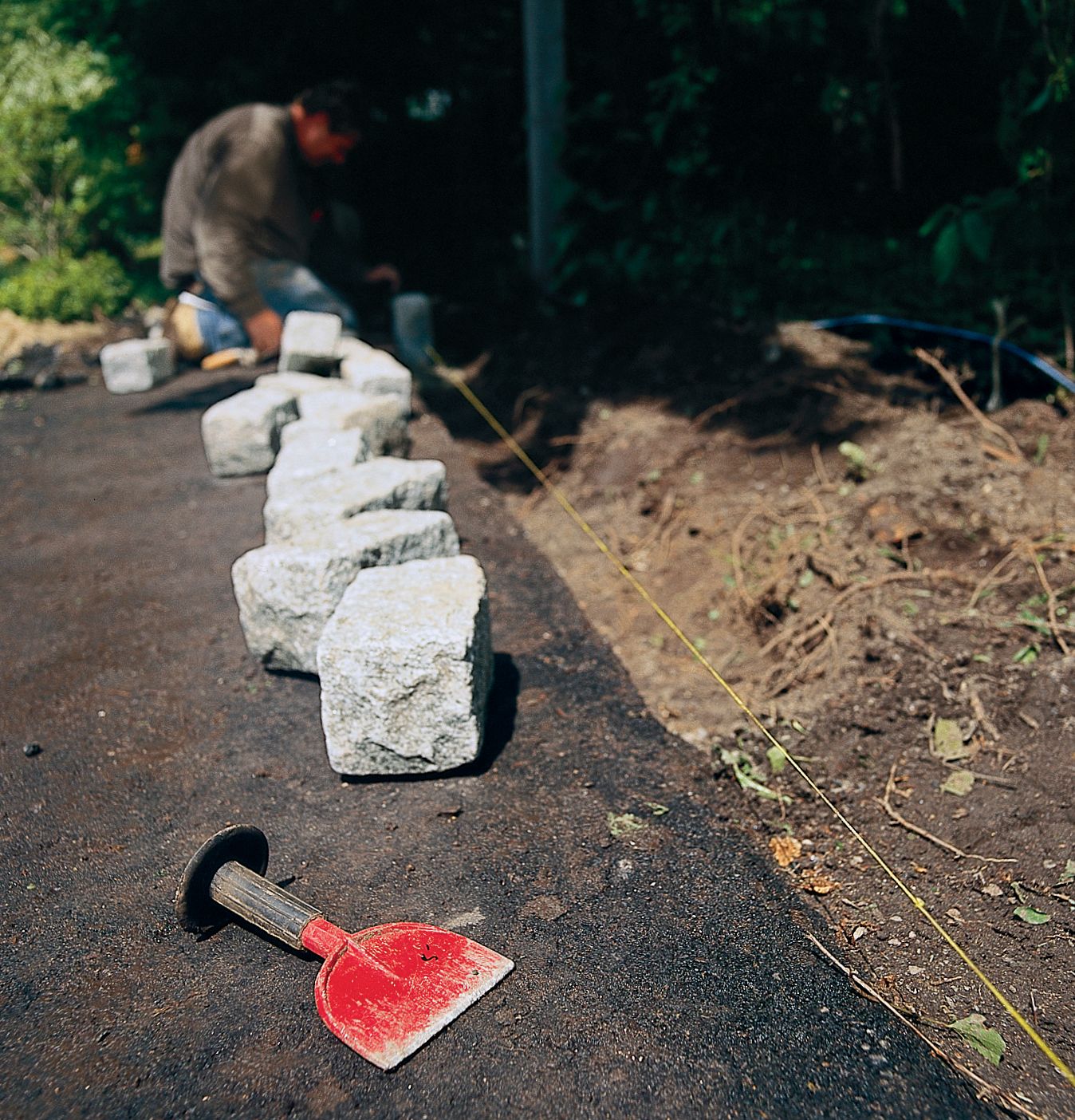
Set up a guide using stakes and mason’s line to create a straight line. Drive two stakes into the ground at the driveway’s edge, no more than 50 feet apart. Tie mason’s line between these stakes, positioning it at a height less than half the depth of the stone above the top edge of the pavement. For example, if you use blocks with a 4-inch exposed face, set the line two inches above the pavement. Check the height along the string and adjust as needed by adding additional stakes.
Step 5: Mix the Concrete Base
Prepare your concrete mix in a wheelbarrow. The concrete should be relatively stiff to prevent it from squeezing up between the blocks during installation. One 80-pound bag of cement and 200 pounds of sand make a 20-foot setting base. Blend the dry materials first — three shovelfuls of sand to each shovel of cement — then add just enough water to make a stiff mix. For more detail, check out our guide to concrete mixing.
Step 6: Set the Blocks
Begin by laying out the first 10 blocks along the pavement near your starting point, which should be at a corner or the most visible end of the driveway. Shovel a few inches of concrete into the trench over a 3-foot stretch, then use a trowel to smooth out the mix.
Set your first block in the concrete, positioning it tightly against the pavement and even with the corner. Continue with the remaining blocks, placing each brick snugly against the last. You can use a rubber mallet to tap the top flush with the mason’s line you set up earlier.
Work carefully along corners for a tight fit between the stone faces. We recommend ending each row with a full-sized stone for the best appearance. If a full block doesn’t fit at the end of a row, use a diamond-bladed saw or grinder to trim the last four stones in the row. Trim each block by the same amount to make the size changes less noticeable and maintain a uniform look around the corner.
Step 7: Finishing Touches
When you’ve set all the blocks, sweep some stone dust (available in bulk at stone yards) or ground limestone (sold in bags at nurseries) into the gap between the blocks and the pavement. Don’t use sand — it attracts ants. Finally, fill behind the blocks with topsoil and plant with grass seed or cover with mulch.
Cost Considerations for Belgian Block Edging
The cost of installing Belgian block driveway edging depends on the driveway’s length, the quality of Belgian blocks chosen, and any additional materials required. If you need to remove old edging or do other preparation work, factor this into the cost.
On average, homeowners can expect to pay $9–$11 per linear foot for Belgian blocks, according to Angi. If you hire a professional, expect to pay around $1,350 for installation on an average-sized driveway.
Maintenance Tips for Belgian Block Borders
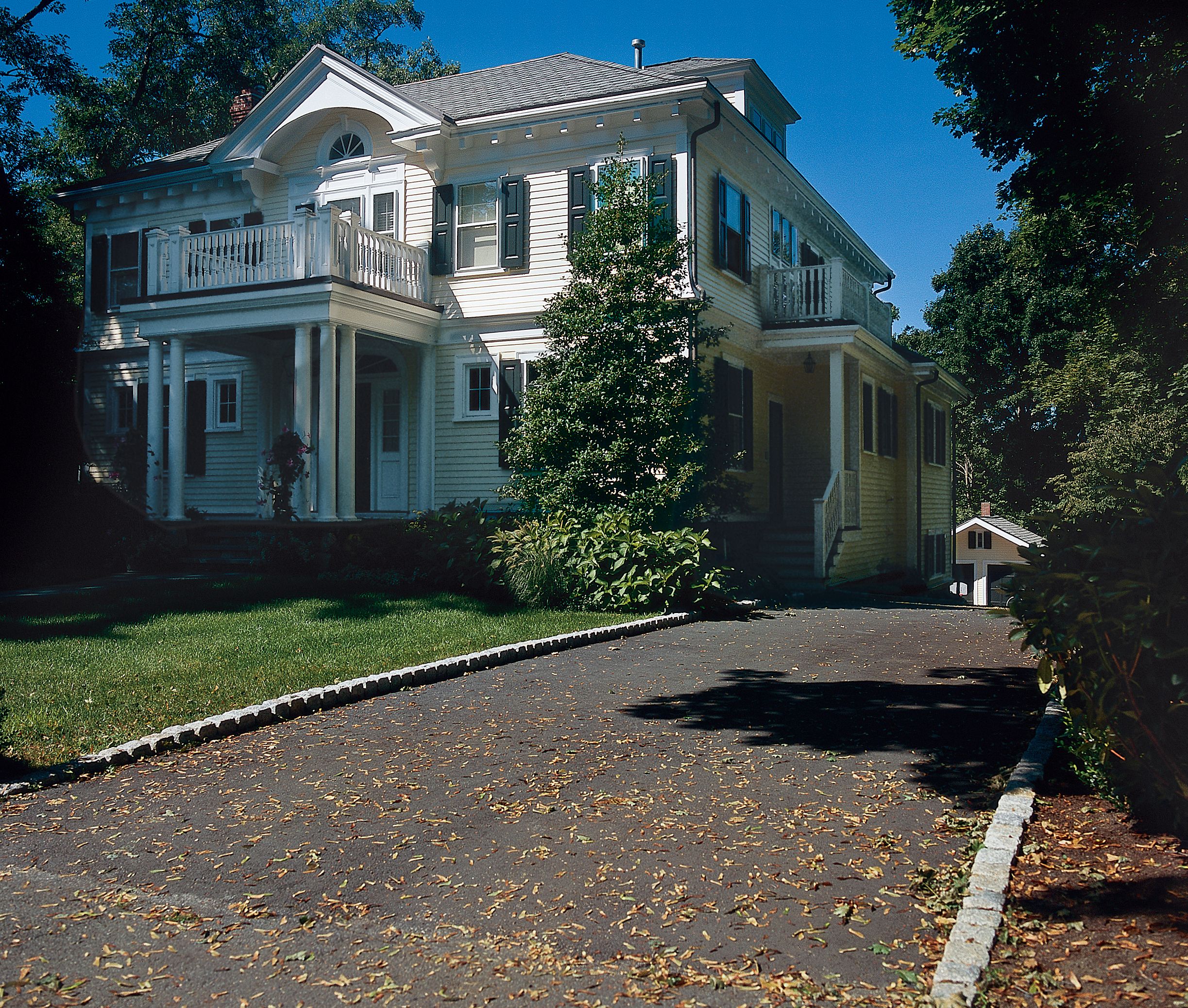
Take these steps to maintain the appearance of your Belgian block edging:
- Sweep the blocks regularly to remove debris.
- Rinse the edging with a garden hose to remove dirt and prevent staining.
- For tougher stains, use a mild detergent and scrub gently with a brush.
- If tar or asphalt is stuck to the blocks, gently chip it away with a chisel.
- Avoid using harsh chemicals that could damage the blocks or surrounding vegetation.
Common Issues
While Belgian block edging is durable, you may encounter some issues over time:
- Shifting blocks: If you notice loose or uneven blocks, reset them in fresh concrete.
- Weed growth: Remove any weeds between blocks and reapply stone dust or limestone filler.
- Winter damage: After harsh winters, inspect your edging for frost heave damage and make necessary repairs.
Alternative Driveway Edging Options
While Belgian block edging is a popular choice, there are other options to consider for your driveway border.
Concrete Curbing
Concrete curbing offers a seamless, modern look and can be poured in continuous sections. It’s durable and can be colored or stamped for increased customization.
Brick Pavers
Brick pavers provide a classic look similar to Belgian blocks but with more color options. They’re often more affordable but may not be as durable as granite blocks. Brick pavers can be arranged in various patterns to create unique designs that add character to your driveway. Read our complete guide to brick pavers.
Natural Stone
Natural stone options, such as fieldstone or cobblestone, can create a rustic or unique border. These may require more skill to install correctly but can result in a one-of-a-kind look.
Our Conclusion
Belgian block edging is a classic, durable, and low-maintenance way to keep your driveway looking great. Though installation requires careful planning and execution, the result is a long-lasting, attractive border that protects your driveway and adds value to your property. Follow the steps outlined in this guide to enjoy a beautifully defined driveway that stands the test of time.
